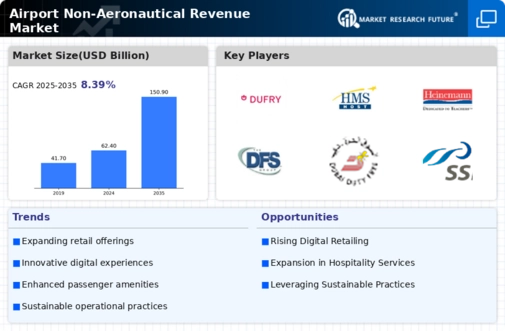Market Growth Projections
The Global Airport Non-Aeronautical Revenue Market Industry is poised for substantial growth, with projections indicating a compound annual growth rate of 8.36% from 2025 to 2035. This growth trajectory is driven by various factors, including increasing passenger traffic, technological advancements, and the diversification of revenue streams. As airports continue to adapt to changing consumer preferences and invest in innovative solutions, the market is expected to expand significantly. The anticipated growth underscores the importance of non-aeronautical revenues in the overall financial health of airports, suggesting that stakeholders must prioritize strategic investments in this sector.
Technological Advancements
Technological advancements play a pivotal role in shaping the Global Airport Non-Aeronautical Revenue Market Industry. Innovations such as mobile applications, contactless payment systems, and data analytics are transforming how airports interact with passengers. For instance, airports are leveraging data analytics to understand passenger behavior and preferences, enabling them to tailor their offerings accordingly. This not only enhances customer satisfaction but also drives sales in retail and dining sectors. Moreover, the integration of technology facilitates seamless transactions, encouraging passengers to spend more during their airport experience. As technology continues to evolve, its impact on non-aeronautical revenue generation is likely to grow.
Increasing Passenger Traffic
The Global Airport Non-Aeronautical Revenue Market Industry is experiencing a notable surge in passenger traffic, which is projected to reach 62.4 USD Billion in 2024. This increase in footfall presents airports with a lucrative opportunity to enhance their non-aeronautical revenue streams. Airports are increasingly investing in retail, dining, and entertainment options to cater to the growing number of travelers. For instance, major airports are expanding their shopping areas and introducing diverse food outlets to attract passengers. This trend not only boosts airport revenues but also enhances the overall passenger experience, indicating a symbiotic relationship between passenger growth and non-aeronautical revenue generation.
Enhanced Passenger Experience
The Global Airport Non-Aeronautical Revenue Market Industry is increasingly focused on enhancing the passenger experience as a means to boost non-aeronautical revenues. Airports are investing in amenities such as lounges, wellness centers, and entertainment options to create a more enjoyable environment for travelers. This focus on passenger comfort not only encourages longer dwell times but also increases spending in retail and dining establishments. For instance, airports that offer premium lounges and relaxation areas often see higher revenue from food and beverage sales. This trend indicates that improving the passenger experience is not merely a service enhancement but a strategic revenue-generating initiative.
Diversification of Revenue Streams
The Global Airport Non-Aeronautical Revenue Market Industry is witnessing a strategic shift towards diversification of revenue streams. Airports are increasingly recognizing the importance of non-aeronautical revenues, which encompass retail, advertising, parking, and real estate. This diversification is crucial as it mitigates reliance on aeronautical revenues, which can be volatile. For example, airports are exploring partnerships with local businesses to create unique shopping experiences and are investing in digital advertising platforms to maximize visibility. This approach not only enhances revenue potential but also fosters community engagement, suggesting that airports are evolving into multifaceted commercial hubs.
Expansion of Duty-Free and Retail Outlets
The Global Airport Non-Aeronautical Revenue Market Industry is significantly benefiting from the expansion of duty-free and retail outlets. Airports are increasingly recognizing the potential of retail as a major revenue driver, leading to the establishment of larger and more diverse shopping areas. For example, major international airports are investing in luxury brands and local artisanal products to attract a wider range of travelers. This expansion is expected to contribute to the projected growth of the market, with revenues anticipated to reach 150.9 USD Billion by 2035. The allure of duty-free shopping, combined with the convenience of airport retail, suggests a promising future for non-aeronautical revenue.




















